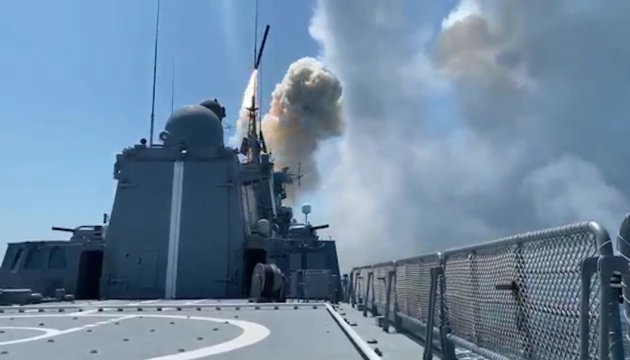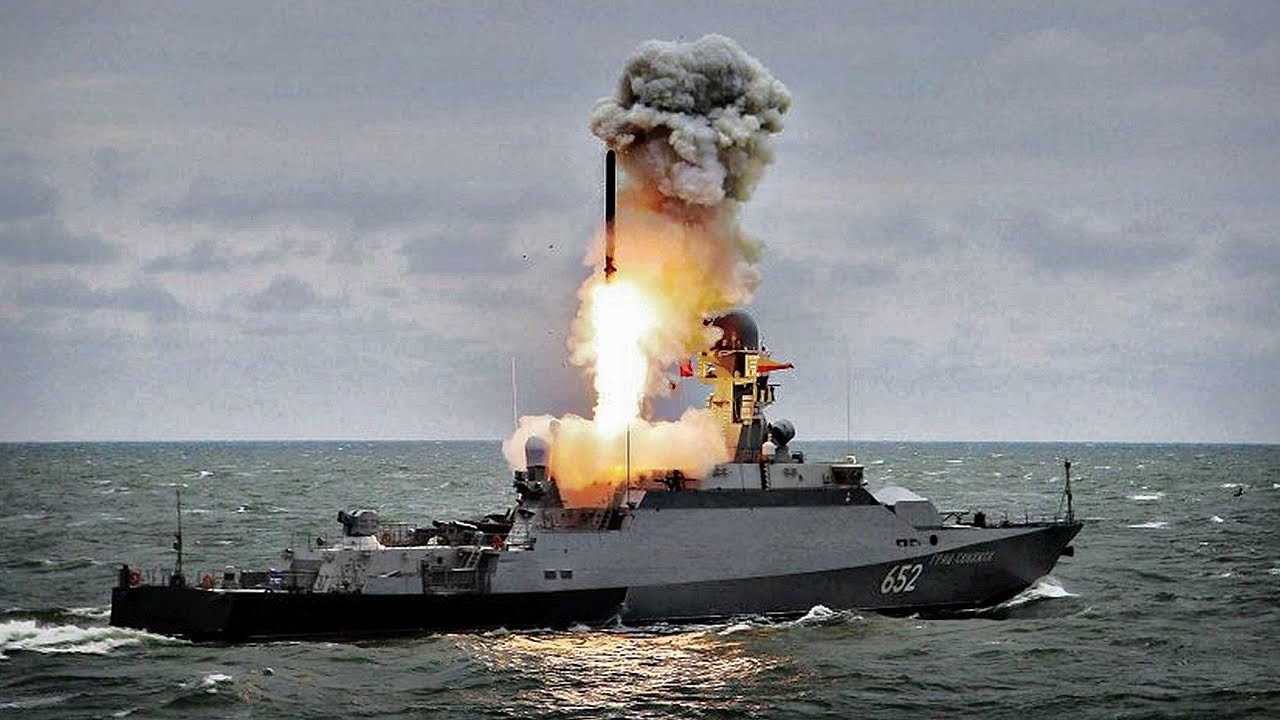Russia confirms timeline for final Buyan-M corvette deliveries
Table Of Content
- Norway’s aim to purchase new frigates may impact Royal Navy’s own fleet production
- SEA to trial sonar software for UK Royal Navy
- US Senate to vote on Ukraine aid package on Tuesday
- Elon Musk concerned about lack of war exit strategy, Ukrainian President's Office responds
- Ukraine hits Russian Buyan cruise missile carrier and Pavel Derzhavin vessel with drones
- SBU, defense forces attack Morozovsk airfield in Russia's Rostov region, at least six aircraft destroyed – source
- SBU, GUR, SOF organize attack on Russia’s energy infrastructure, objects in eight regions hit at night – source
- Missiles, air defences, artillery shells - why $61bn bill is a lifeline for Ukraine

A cruise missile is a guided missile, making them highly precise at striking targets hundreds or even thousands of miles away. Ukrainian intelligence asserted that a large landing ship, Minsk, and the submarine Rostov-on-Don were struck and considered beyond repair. In recent months, Ukraine has conducted a number of operations in Crimea, with many successful strikes. Russia often claims drone attacks, local Telegram channels report explosions and the occupying authorities traditionally close the bridge connecting the peninsula to Russia.

Norway’s aim to purchase new frigates may impact Royal Navy’s own fleet production
This incident follows a recent event where a patrol ship of the Russian Black Sea Fleet, the Pavel Derzhavin, was damaged near Sevastopol on Oct. 11. While the Ukrainian Navy confirmed the ship’s damage, they did not provide specific details about the incident. Local Telegram channels reported that the Pavel Derzhavin may have hit a Russian mine.
SEA to trial sonar software for UK Royal Navy
And over the decades, several attempts by the Americans to sustain a new cruiser program have foundered. Production of Project Buyan-M-class small missile corvettes for the Russian Navy is set to continue for two more years to fully satisfy the service’s needs. The tenth vessel in class, Grad, was launched at Gorky Shipyards on 17 September and is slated to be followed by two more, ordered by the Russian MoD in September 2016.
US Senate to vote on Ukraine aid package on Tuesday
In just three years starting in mid-2017, the Chinese People’s Liberation Army Navy launched eight new Type 055 cruisers. Each Type 055 displaces 12,000 tons and packs 112 vertical-launch cells for anti-air, anti-ship and land-attack missiles. Initial information about a modified Project 21631, dubbed Buyan-M, was published in August 2010. The Project ships were to be an updated variant of the Project Buyan small artillery ships.
For a quarter-century, the Ticos have been the obvious choice for ADC. Of all the Navy’s roughly 100 surface combatants, they have the most missiles, the best sensors and the most space for a captain and their staff. Because the ADC vessel is the flattop’s last line of defense, the Navy assigns only its most heavily-armed ships to the role. Perhaps more importantly, the Ticos have a full suite of radars in the L, S and X bands, plus the space and communications equipment they need to function as “air-defense commander” ships for aircraft carrier battle groups. But from a certain point of view, the fleet already is replacing the old cruisers. The Russian navy operates 74 warships and 51 submarines, while the army has more than 13,300 tanks, almost 20,000 armoured fighting vehicles, and nearly 6,000 pieces of artillery.
Ukraine hits Russian Buyan cruise missile carrier and Pavel Derzhavin vessel with drones
So a Flight III is roughly the same displacement as a Tico and has 26 fewer missiles than the cruiser does, but has better sensors—the same sensors that should wind up in the DDG(X). After all, the Navy expect to decommission the first 11 Ticos between 2022 and 2026. The new DDG(X), a de facto cruiser, can’t possibly join the fleet before the mid-2030s. Its skipper usually is an experienced officer holding the rank of captain. Where the other surface warships in a carrier group might leave the group for days or weeks at a time to conduct their own, independent missions—the ADC ship never leaves the carrier.
The answer to the former question is yes, according to a 2014 testimony before a U.S. House of Representatives subcommittee by Rear Adm. Thomas Rowden, then commander of the Navy’s surface fleet. The way the Navy describes and classifies its ships has a tendency to obscure how big and powerful many of these ships are—and what roles they perform. Russia’s Kh-47M2 Kinzhal air-launched ballistic missile, for example, can allegedly reach Mach 10, equivalent to more than 7,600mph.
Details of the operation and the means of attack are not being officially disclosed at this time. A Ukrainian ministerial advisor, Anton Gerashchenko, also posted footage that appeared to show a large blaze at the shipyard. The first Flight III, the future USS Jack H. Lucas, could commission in 2023. A Flight III Burke has the same number of missile cells as a Flight IIA—96—but the variant comes with a brand-new main sensor, the powerful SPY-6(V)1 Air and Missile Defense Radar.
The ships are primarily designed for coastal zone operations to protect Russia’s vast coastal areas. Due to the small tonnage, they can operate even in shallow areas of oceans and seas and Russia’s extensive inland waterway system. The Crimean Wind Telegram channel initially reported an explosion on a Russian Buyan-M missile carrier and posted a video of the ship in smoke. In September, Ukraine damaged two ships at the port of Sevastopol in Crimea, in a move that analysts said prompted Russia to redistribute much of its fleet away from the key port. The ship didn't even have time to join the fight, a spokesperson for the Ukrainian air force, Yuriy Ihnat, told broadcasters.
Russia's Ministry of Defense admitted damage to one of its ships on Saturday, saying Ukraine had launched a barrage of 15 cruise missiles at the shipyard, which it referred to by its alternative name of Butomy, the state-owned news agency RIA Novosti reported. There’s no confirmation of damage to the Buyan-M class cruise missile carrier, which was earlier reported to have been targeted as well. The Russian Navy are is subsonic 3M14 Kalibur land attack cruise missiles from ships and submarines. Graivoron becomes the fourth “small missile ship” (the official Russian Navy designation for the type) of the Black Sea Fleet. It joined the 41st brigade of missile boats of the Black Sea Fleet, which already includes the Vyshny Volochek, Orekhovo-Zuevo and Ingushetia built as part of the same contract and commissioned between 2018 and 2019.
Oleshchuk added that Russia was keeping one of its most modern warships, which is capable of carrying Kalibre cruise missiles, at Zaliv. It doesn't include the specifically anti-ship missiles whose list is separate. The 9,800-ton Ticos aren’t the biggest surface combatants in the fleet—that honorific belongs to the three 15,900-ton Zumwalt-class destroyers. From a certain point of view, the latest Flight III variant of the U.S. fleet’s workhorse Arleigh Burke-class destroyer, or DDG, could—and should—qualify as a cruiser.
Russian Buyan-M class Corvette fired Kalibr missiles Against Ukraine - Naval News
Russian Buyan-M class Corvette fired Kalibr missiles Against Ukraine.
Posted: Mon, 28 Mar 2022 07:00:00 GMT [source]
Ukrainian intelligence asserted that a large landing ship, Minsk, and the submarine Rostov-on-Don were struck and damaged beyond repair. “Due to the small tonnage, they can operate even within shallow parts of oceans and seas, as well as Russia’s river system. This feature allows Buyan-class corvettes to easily change their dislocation point and hide within rivers. It’s also important if you need to change theaters of probable combat operations,” he says.
The Navy later clarified that there was no confirmation of damage to the Buyan-M class cruise missile carrier, but confirmed the damage to Nikolai Muru rescue tugboat during the attack. The Buyan cruise missile carrier was unable to repeat Alrosa's ‘heroic deed’ and was hit by experimental Sea Baby drone weapons at the Sevastopol raid today. The Security Service has not disclosed any details yet but added that both vessels were hit by Sea Baby drones with experimental weapons. Each Tico boasts 122 vertical cells for launching anti-air missiles and cruise missiles. The current Flight IIA Arleigh Burke-class destroyers, each displacing around 9,500 tons, boast 96 cells apiece.
“The Flight III DDGs will replace the cruisers at least initially, and then the DDG(X) will take over as the primary ‘large surface combatant’ class,” explained Bryan McGrath, director of the FerryBridge Group naval consultancy in Maryland. Indeed, over time the term “cruiser” more or less have become synonymous with the air-defense commander role. In the Navy, for as long as almost anyone in the fleet can remember, cruisers do ADC and the ADC job goes to cruisers. Russia is known to have Kh-55SM cruise missiles, which can travel 3,000km at subsonic speeds and hit a target with an accuracy of 15 metres using an inertial navigation system. Dr Sidharth Kaushal, a research fellow for sea power and missile defence at the Royal United Services Institute, said it is unclear how many cruise missiles Russia currently has.
Comments
Post a Comment